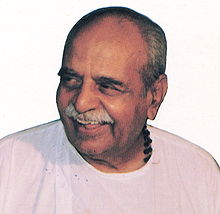- Moropant Pingley
-
Shri Moropant Pingley 
Moreshwar Nilkanth PingleyBorn December 30, 1919
Jabalpur, Madhya Pradesh, IndiaDied September 21, 2003 (aged 83)
Nagpur, Maharashtra, IndiaNationality Indian Education Bachelor of Arts in English from Morris College, Nagpur Organization Rashtriya Swayamsevak Sangh, Vishwa Hindu Parishad Religion Hinduism Moreshwar Nilkanth Pingley (मोरेश्वर निळकंठ पिंगळे), often referred as 'Moropant', was a senior RSS leader in India. He is merited (in Marathi) as "हिन्दु जागरणाचा सरसेनानी", literally, "Commander of Hindu awakening". During his 65 years of service as a संघ प्रचारक (Sangh Pracharak: one who is appointed to instill the culture and values of RSS amongst people), he held numerous berths, most notable of them being the अखिल भारतीय बौध्दिक प्रमुख (All-India Intellectuals Chief). He was one of the six unofficial Sarsanghchalaks during the 1975 emergency in India. He was reported by the Indian media as the "Field Marshal" of the Ram Janmabhoomi movement, which resulted in the demolition of the Babri Masjid in 1992. Numerous projects were undertaken under his mentorship: गौ-संशोधन (research on cows), सरस्वती नदी शोध (tracing the underground Saraswati river), ईतिहास पुनर्लेखन (re-writing Indian history), to name a few. This made him earn the title of Sangh's प्रकल्प पुरुष (literally, Project-Man). Moropant shunned publicity. He would be best described as one who is everywhere yet nowhere; well-known and yet less known, pervasive and yet never intrusive and lived in the true spirit of a Swayamsevak.
Contents
Early years in RSS
Moropant was one of the few honed under the mentorship of both Dr.Hedgewar and Shri Guruji. After graduating with a Bachelor's degree in English in 1941, he became a full time संघ प्रचारक (Sangh Pracharak). In 1946, at the age of 26, he was appointed as सहप्रांतप्रचारक (assistant to Pracharak at state level) of Maharashtra. His most notable contribution during his early years was bridging the gap between factions in RSS, which developed due to rumours relating to Shri Guruji's involvement in Mahatma Gandhi's murder.
First Ekatmata Yatra
The conversion of hundreds of Hindus at Meenakshipuram in 1981 led to organisation of the first Ekatmata Yatra [1] (एकात्मता यात्रा) by VHP in 1983. Due to his excellent organisational skills, Moropant was given the responsibility of planning, co-ordinating and executing the Yatra. During its planning, Moropant extensively traveled around India. His effective selection of routes to be taken by the Ekatmata Raths (chariots), magnified the impact of the Yatra.
"Ram-Janki" Rath Yatra
The first Ekatmata Yatra in 1983 was followed by the "Ram-Janki" Rath Yatra in 1984. It was a precursor to the Ram Janmabhoomi movement. The aim of this Yatra was to reunite the Hindus, and to kindle the feeling of pride amongst them. Seven chariots traveled through Bihar and Uttar Pradesh, where Lord Shriram was shown behind bars depicting His state inside the Ram temple in Ayodhya. Moropant was appointed as the convener and contoller of this Yatra. In 1986, the Faizabad court ordered to unlock the temple marking the awakening of the Hindu society.
References
External links
- The Kulpati
- http://timesofindia.indiatimes.com/articleshow/194212.cms
- Prime Minister Vajpayee condoles Moropant Pingle's death
- Just days ago, Sangh turned to Vaastu to ward off Parivar cloud
- http://www.organiser.org/dynamic/modules.php?name=Content&pa=showpage&pid=28&page=24
- http://www.bridgeofram.com/2008/06/dr-s-kalyanaraman-awarded-19th-dr.html
Categories:- Indian activists
- Indian Hindus
- People from Jabalpur
- 1919 births
- 2003 deaths
Wikimedia Foundation. 2010.
